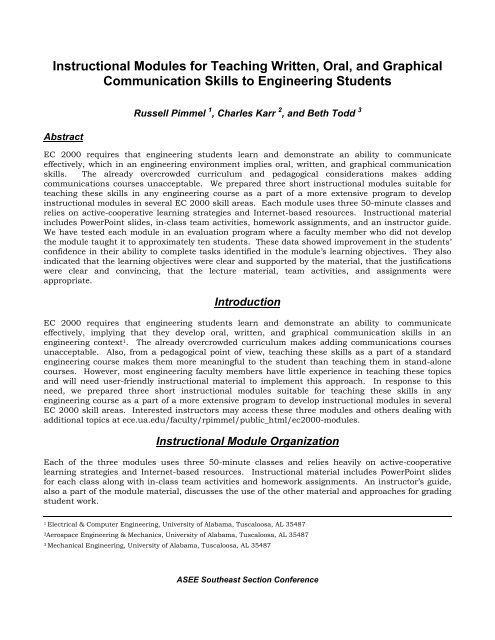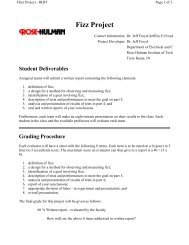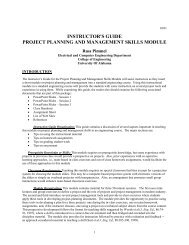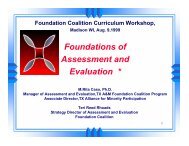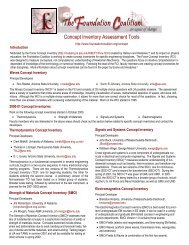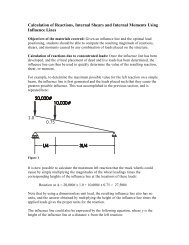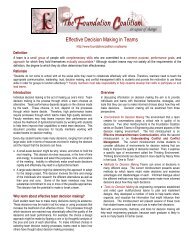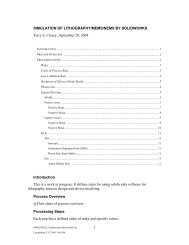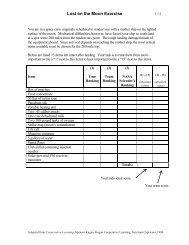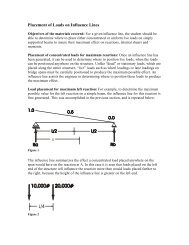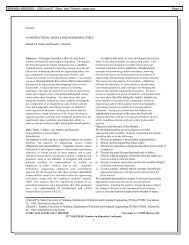Instructional Modules for Teaching Written, Oral, and Graphical ...
Instructional Modules for Teaching Written, Oral, and Graphical ...
Instructional Modules for Teaching Written, Oral, and Graphical ...
You also want an ePaper? Increase the reach of your titles
YUMPU automatically turns print PDFs into web optimized ePapers that Google loves.
<strong>Instructional</strong> <strong>Modules</strong> <strong>for</strong> <strong>Teaching</strong> <strong>Written</strong>, <strong>Oral</strong>, <strong>and</strong> <strong>Graphical</strong>Communication Skills to Engineering StudentsAbstractRussell Pimmel 1 , Charles Karr 2 , <strong>and</strong> Beth Todd 3EC 2000 requires that engineering students learn <strong>and</strong> demonstrate an ability to communicateeffectively, which in an engineering environment implies oral, written, <strong>and</strong> graphical communicationskills. The already overcrowded curriculum <strong>and</strong> pedagogical considerations makes addingcommunications courses unacceptable. We prepared three short instructional modules suitable <strong>for</strong>teaching these skills in any engineering course as a part of a more extensive program to developinstructional modules in several EC 2000 skill areas. Each module uses three 50-minute classes <strong>and</strong>relies on active-cooperative learning strategies <strong>and</strong> Internet-based resources. <strong>Instructional</strong> materialincludes PowerPoint slides, in-class team activities, homework assignments, <strong>and</strong> an instructor guide.We have tested each module in an evaluation program where a faculty member who did not developthe module taught it to approximately ten students. These data showed improvement in the students’confidence in their ability to complete tasks identified in the module’s learning objectives. They alsoindicated that the learning objectives were clear <strong>and</strong> supported by the material, that the justificationswere clear <strong>and</strong> convincing, that the lecture material, team activities, <strong>and</strong> assignments wereappropriate.IntroductionEC 2000 requires that engineering students learn <strong>and</strong> demonstrate an ability to communicateeffectively, implying that they develop oral, written, <strong>and</strong> graphical communication skills in anengineering context 1 . The already overcrowded curriculum makes adding communications coursesunacceptable. Also, from a pedagogical point of view, teaching these skills as a part of a st<strong>and</strong>ardengineering course makes them more meaningful to the student than teaching them in st<strong>and</strong>-alonecourses. However, most engineering faculty members have little experience in teaching these topics<strong>and</strong> will need user-friendly instructional material to implement this approach. In response to thisneed, we prepared three short instructional modules suitable <strong>for</strong> teaching these skills in anyengineering course as a part of a more extensive program to develop instructional modules in severalEC 2000 skill areas. Interested instructors may access these three modules <strong>and</strong> others dealing withadditional topics at ece.ua.edu/faculty/rpimmel/public_html/ec2000-modules.<strong>Instructional</strong> Module OrganizationEach of the three modules uses three 50-minute classes <strong>and</strong> relies heavily on active-cooperativelearning strategies <strong>and</strong> Internet-based resources. <strong>Instructional</strong> material includes PowerPoint slides<strong>for</strong> each class along with in-class team activities <strong>and</strong> homework assignments. An instructor’s guide,also a part of the module material, discusses the use of the other material <strong>and</strong> approaches <strong>for</strong> gradingstudent work.1 Electrical & Computer Engineering, University of Alabama, Tuscaloosa, AL 354872Aerospace Engineering & Mechanics, University of Alabama, Tuscaloosa, AL 354873 Mechanical Engineering, University of Alabama, Tuscaloosa, AL 35487ASEE Southeast Section Conference
In each session, we alternate cooperative learning exercises with short mini-lectures describing someestablished ideas on the topic. This approach provides some instruction in the skill, followed by achance to practice it, followed by a chance to see <strong>and</strong> evaluate other students’ ef<strong>for</strong>ts <strong>and</strong> to have theirwork evaluated both by students <strong>and</strong> the instructor, all important steps in learning a skill 2, 3 . Ideallythe instructor would then give an assignment later in the semester on the st<strong>and</strong>ard course materialthat involved the skill (e. g., give a <strong>for</strong>mal presentation summarizing the results of an extended designproject). Besides providing another opportunity to practice the skill, this later assignment extends theskill into an engineering context making it much more relevant to the students 4 .Learning ObjectivesRestricting the modules to three classes <strong>for</strong>ced us to select a subset of material <strong>for</strong> each of the threemodules. Table 1 shows the topics <strong>for</strong> each session <strong>for</strong> the modules.Session<strong>Oral</strong>Communications<strong>Written</strong>Communications<strong>Graphical</strong>Communications1 Strategies <strong>for</strong> effectivepresentationsKey components inexecutive summariesGraphing data <strong>and</strong>interpreting graphs2 Student presentations Process <strong>for</strong> writingexecutive summaries3 Student presentations Identifying well writtenexecutive summariesSketching diagramsData <strong>and</strong> figures inreportsTable 1. Topics <strong>for</strong> each session in the three modules.We focus the oral communications module on strategies <strong>for</strong> making oral presentations. We expectthat after completing the module, students should be able to:(1) Write guidelines <strong>for</strong> effective presentation(2) Plan, prepare, <strong>and</strong> deliver a presentation(3) Critique a presentation (provided evaluation received adequate class time <strong>and</strong> emphasis)The first session provides instruction on strategies <strong>for</strong> making an effective presentation <strong>and</strong>, if theinstructor chooses to spend the time, on approaches <strong>for</strong> evaluating presentations. At the end of thissession, the instructor assigns teams of students to prepare talks on some aspect of presentations.They prepare these talks using references, normally found on various web sites, <strong>and</strong> deliver them inthe second <strong>and</strong> third session.We focus the written communications module on executive summaries as a representative <strong>for</strong>m oftechnical writing. We design the material so that, after completing the module, the students shouldbe able to:(1) Distinguish between well-written <strong>and</strong> poorly-written executive summaries(2) Identify the attributes of a well-written executive summary(3) Write an effective executive summary on a topic in the course where the module is offeredASEE Southeast Section Conference
The written communications module requires no specific prerequisite knowledge. However, it is best ifstudents have successfully completed a fundamental English composition course. In the first sessionstudents are introduced to the key components of an executive summary, <strong>and</strong> at the end of the periodthey should be able to list <strong>and</strong> describe these key components. The objective of the second session isto have the students develop a process that they can use to write an executive summary. In the thirdsession students learn to identify well-written abstracts <strong>and</strong> executive summaries, <strong>and</strong> are providedconstructive feedback <strong>and</strong> ideas to assist them in improving their writing.We focus the graphical communications module on the types of figures that would be included in atechnical report, as well as the types of sketches that are needed to support engineering calculations.After completing the module, the students should be able to:(1) Plot data correctly on paper or the computer(2) Draw simple sketches including free body diagrams, circuit diagrams, system diagrams,<strong>and</strong> process diagrams(3) Use figures correctly when writing a report(4) Interpret graphical data(5) Read schematic drawingsThe module is designed so that the instructor can pick <strong>and</strong> choose topics that are most important <strong>and</strong>relevant <strong>for</strong> the students in the course without losing continuity. Some of the assignments make useof spreadsheets, such as Excel, <strong>and</strong> the module assumes that the students have had previousspreadsheet exposure. The first session provides rules <strong>for</strong> graphing <strong>and</strong> interpreting linear <strong>and</strong> nonlineardata. The second day continues with plotting logarithmic experimental data <strong>and</strong> then moves onto sketching the types of diagrams needed <strong>for</strong> engineering calculations. The third class period is usedto discuss how data <strong>and</strong> figures should be presented in technical reports. Communication usingschematic diagrams is discussed, <strong>and</strong> primary references <strong>for</strong> st<strong>and</strong>ard symbols used in severaldifferent disciplines are provided.Team ExerciseIn the introductory material in the first session of the oral communication module, the presentationprocess is subdivided into three phases: planning, preparing, <strong>and</strong> delivering. The material contains afew slides on strategies <strong>for</strong> dealing with each of these phases. The section on preparing presentationscontains additional material on preparing good Power Point slides. This session contains two teamexercises, each taking about ten minutes of class time. The first asks the students to prepare a set ofguidelines <strong>for</strong> effective presentation while the second asks <strong>for</strong> a set of Power Point slides. These teamexercises actively involve the students <strong>and</strong> get them thinking about the characteristics of goodpresentations <strong>and</strong> slides, making them more receptive to the material presented by the instructor.Announcing ahead of time that a few r<strong>and</strong>omly selected teams will have to report their resultsencourages all students to take these exercises seriously. Also, the material includes a briefdiscussion of teaming strategies just be<strong>for</strong>e the first team exercise in order to remind the students ofsome of these ideas.The written communications module contains team exercises in each of the three sessions. To give anindication of the types of exercises that are included, consider the second session. Session two iscomprised of several short periods. In the first segment of the session, students are asked to critiqueeach other’s executive summaries written <strong>for</strong> homework after session one. This exercise allows <strong>for</strong> theASEE Southeast Section Conference
students to (1) see alternative ways of attacking the problem they were assigned as homework, <strong>and</strong> (2)receive some feedback from their peers. It is vital that students put <strong>for</strong>th ef<strong>for</strong>t to make their feedbackmeaningful <strong>and</strong> constructive. In the second segment of the session students are asked to develop aprocess by which they can write an executive summary. The in-class, team exercise is <strong>for</strong> them to dojust that. It is important to note that they typically go into this exercise totally confused. Thus, theinstructor generally has to “get them started” by spotting them something like “clearly identify youraudience” or “start by writing the objective of the paper.” However, when students work hard at thisexercise, the rest of the module is far more meaningful to them. To properly motivate the students, theassignment is submitted <strong>for</strong> a grade.In the first session of the graphical communications module, students work in teams to develop anunderst<strong>and</strong>ing of the importance of this topic to an engineer. They develop a definition of graphicalcommunication <strong>and</strong> reasons <strong>for</strong> its significance. These team exercises are followed by mini-lectureswith discussion on the importance of graphical communication. In the first session, they are alsogiven sample graphs containing errors in labeling, units, <strong>and</strong> other problems commonly made byundergraduate students. The purpose of these incorrect graphs is to allow students to recognize howdifficult it can be to interpret a graph that is not <strong>for</strong>matted correctly. Then they are more willing tolisten to the follow-up lecture on “10 Rules <strong>for</strong> Graphing”. The second day involves the actual plottingof some simple graphs. It is recommended that in-class exercises on this day be done as individualsso that everyone has practice putting pencil to paper. In the third session, students work in teams asthey answer questions about figures <strong>and</strong> schematic diagrams that are presented to them.Homework AssignmentsThe oral communication module contains two types of homework assignments. The first type weresimple exercises that encourages the students to think about the importance of good presentationskills <strong>and</strong> to consider, organize <strong>and</strong> prioritize the factors that lead to effective preventions. Samplequestions were “List two reasons why engineers need to develop good presentation skills.“ <strong>and</strong> “Preparea single list of the five most important guidelines <strong>for</strong> planning, preparing, <strong>and</strong> delivering a talk. Write asentence or two justifying your choices.” The second type of assignment directs the students to websites or printed material <strong>and</strong> requires them, normally as members of a team, to prepare a short talkon some topic dealing with presentation skills (e. g., common mistakes in delivering, preparing <strong>for</strong>questions, preparing <strong>for</strong> a hostile audience, or dealing with nervousness).In the written communications module students are given a pre-assignment to write an executivesummary on an assigned topic be<strong>for</strong>e coming to the first session. At the end of the first session,students refine their executive summaries based on in<strong>for</strong>mation presented in the session. After thesecond session, students are assigned a new topic <strong>and</strong> are required to produce an executive summaryby implementing the process they developed in the session. Finally, students are given a technicalreport <strong>and</strong> required to produce the executive summary.The assignments in the graphical communication module allow students to gain experience in plottingdata in Excel. In the final assignment, they are given a large table of data to plot in Excel <strong>and</strong> theninsert into a short Word document. Upperclassmen often have difficulty in putting data into reportsdue to trying to manipulate the large data files. Tips <strong>for</strong> doing this are included in the third classperiod, <strong>and</strong> this homework assignment gives students the opportunity to practice what they havelearned.Instructor’s GuidesThe instructor’s guide <strong>for</strong> each of the modules follows a similar <strong>for</strong>mat <strong>and</strong> discusses several issuesASEE Southeast Section Conference
that are important to an instructor using this material. The major sections provide tips on:• Using the instructional material,• Homework assignments,• Grading student work,• Assessment.Evaluation ProceduresWe have tested each module in an evaluation program. In order to see how the material stood on itsown, they were taught by a faculty member who did not develop the material, while the moduledeveloper <strong>and</strong> a third faculty member observed the class. The instructor <strong>and</strong> the observer bothcompleted evaluation <strong>for</strong>ms <strong>and</strong> made suggestions to the developer <strong>for</strong> improving the material.The modules were taught to approximately ten students during a st<strong>and</strong>ard 50-minute period on aMonday, Wednesday, <strong>and</strong> Friday schedule. Students receiving the instruction, referred to as the“experimental group”, competed several evaluation <strong>for</strong>ms prior to the start of the module <strong>and</strong> at theend of the module. In addition, we collected data from a second group of students who were involvedin a module on a completely different topic <strong>and</strong> served as a “control group. Both groups werer<strong>and</strong>omly selected from a larger group of paid volunteers after screening <strong>for</strong> schedule conflicts. Theoverall group contained 65 % seniors, 25 % juniors, <strong>and</strong> 10 % sophomores; 45 % had a GPA above 3.0while 55 % had one between 2.0 <strong>and</strong> 3.0; <strong>and</strong> 61 % had one or more coop or intern experiences, while39 % had none.One survey <strong>for</strong>m asked the students to assess their confidence in their ability to complete tasksrepresentative of the module’s learning objectives <strong>and</strong> to indicate their confidence using a five-valuedscale (i. e., 1 - “Strongly Disagree” … 5 - “Strongly Agree”). In creating this list of tasks, we convertedeach objective into one <strong>and</strong> only one statement so that there was a one-to-one correspondencebetween the modules’ learning objectives <strong>and</strong> students’ confidence statements. For example, theobjective, “Students should be able to write guidelines <strong>for</strong> an effective presentation” became “I amconfident that I can write guidelines <strong>for</strong> an effective presentation.” We collected post-module <strong>and</strong> controldata with all three modules, but we collected pre-module data only with the written <strong>and</strong> graphicalcommunication modules. We averaged the selected values <strong>for</strong> each task <strong>and</strong> we will refer to thisaverage as a “confidence score”. We then averaged the confidence scores <strong>for</strong> all tasks in a module toobtain an “average confidence score” <strong>for</strong> each module.In a second survey, we asked the students to indicate their agreement with a set of statementsdescribing the appropriateness, effectiveness <strong>and</strong> completeness of the material. For example, we askedthem to indicate their agreement with “The learning objectives were clear” <strong>and</strong> “The instructionalmaterial supported the learning objectives.” Figure 5 (which is discussed later) contains a complete listof these questions in a slightly abbreviated <strong>for</strong>m. Again we used a five valued scale (i. e., 1 - “StronglyDisagree” … 5 - “Strongly Agree”). We averaged the selected values <strong>for</strong> each statement, <strong>and</strong> we willrefer to this average as the “agreement score”. The survey <strong>for</strong>m also provided opportunities <strong>for</strong> writtencomments on the appropriateness, effectiveness <strong>and</strong> completeness of the material.ResultsFigure 1, 2, <strong>and</strong> 3 show the confidence scores <strong>for</strong> each task in each of the three modules. In general,the post-module confidence scores are higher than the pre-module <strong>and</strong> the control values suggestingsome improvement in the students’ confidence in their ability to per<strong>for</strong>m tasks derived from themodules’ learning objectives.ASEE Southeast Section Conference
The data in Figure 1 shows that in the oral communications module the average confidence score werehigher in the post-module group than in the control group (we did not obtain a pre-module survey inthis module). The task “Evaluate <strong>and</strong> critique an oral presentation” showed the largest difference -- 0.7which means that on the average70 % of the students selected a higher value in the post–modulegroup than in the control group. Two other tasks showed a difference of 0.4 (implying that 40 % of thestudents selecting a higher value); these dealt with delivering <strong>and</strong> planning a presentation.A comparison of the pre-module <strong>and</strong> post-module data <strong>for</strong> the written communication module (Figure2) indicates a fairly substantial increase in the students’ confidence to do all three tasks as a result ofthe instruction in the module. The task on identifying attributes of a well-written summary increasedby 0.9 while the task on writing a summary increased by 0.6; these differences imply that 90 % <strong>and</strong>60 %, respectively, of the students selected a higher value after the module. Differences between thepost-module <strong>and</strong> control confidence scores were inconsistent showing a positive difference <strong>for</strong> onetask <strong>and</strong> a negative difference <strong>for</strong> the other two. Similar difference exist between the control <strong>and</strong> premoduledata implying a difference in the experimental <strong>and</strong> control groups, making it hard to identifyany effects of the module by group comparisons.Evaluate <strong>and</strong>critique an oralpresentationDeliver aneffectivepresentationPrepare aneffectivepresentationPlan an effectivepresentationWrite guidelines<strong>for</strong> effective oralpresentationsControlPost ModuleWrite aneffectiveexecutivesummaryIdentify theattributes of awell-writtenexecutivesummaryDistinguishbetween well<strong>and</strong>poorlywrittenexecutivesummariesControlPost ModulePreModule1 2 3 4 5Confidence Score1 2 3 4 5Average Confidence ScoreFigure 1. Confidence scores <strong>for</strong> tasks based oneach objective in oral communication moduleFigure 2. Confidence scores <strong>for</strong> tasks based oneach objective in written communication moduleFigure 3, the confidence scores <strong>for</strong> the graphical communication module, show smaller differencesthan seen with the other two modules. We attribute this lack of effect to the high “baseline” values (i.e., the pre-module <strong>and</strong> control values), which averaged about 4.4 in both cases. These high valuesimplied that, even be<strong>for</strong>e the instruction in the module, 40 % of the students “Strongly Agreed “ thatthey could per<strong>for</strong>m the task while 60 % “Agreed”, leaving little room <strong>for</strong> improvement. In spite of this,the confidence scores did improve in four of the five tasks in the experimental group, <strong>and</strong> they werehigher in the post-module data than in the control data.Figure 4 shows the average confidence scores <strong>for</strong> the three modules. These data summarize theobservation made in the previous three paragraphs discussing the three modules individually. In theoral <strong>and</strong> written communication modules, these averages show differences between post-module <strong>and</strong>both pre-module <strong>and</strong> control averages implying that the module instruction had a positive effect onthe students’ confidence to per<strong>for</strong>m oral <strong>and</strong> written communications tasks. For the graphicalcommunication module, the data show the high baseline values (pre-module <strong>and</strong> control data) <strong>and</strong>little difference post module. Again these data represent changes in student confidence to do specifictasks; clearly, a process that actually tests their ability to do these tasks would be more convincing,<strong>and</strong> we plan to conduct such a test in the future.ASEE Southeast Section Conference
Read schematic drawings<strong>Graphical</strong>Interpret graphical dataUse figures correctly when writinga reportControlPost ModulePreModule<strong>Written</strong>ControlPost ModulePreModuleDraw simple sketches (e. g., freebody diagrams)<strong>Oral</strong>Plot data correctly on paper or thecomputer1 1.5 2 2.5 3 3.5 4 4.5 5Average Confidence ScoreFigure 3. Confidence scores <strong>for</strong> tasks based oneach objective in graphical communicationmodule1 1.5 2 2.5 3 3.5 4 4.5 5Average Confidence ScoreFigure 4. Average confidence scores <strong>for</strong> tasksbased on objectives in oral, written, <strong>and</strong>graphical communication modulesFigure 5 shows the agreement scores with various statements about the appropriateness, effectiveness<strong>and</strong> completeness of the instructional material. In general, these data indicate that the learningobjectives were clear <strong>and</strong> supported by the instructional material, that the justifications were clear<strong>and</strong> convincing, that the lecture material, team activities, <strong>and</strong> assignments were appropriate, asindicated by agreement scores usually greater than 4.0 – the value associated with the descriptor“Agree”. The students did give lower scores to statements about the completeness <strong>and</strong>appropriateness of the material <strong>and</strong> to the statement about the readiness <strong>for</strong> release. The averagesacross the three modules <strong>for</strong> these three statements were 3.5, 3.7, <strong>and</strong> 3.3, respectively.Material ready <strong>for</strong> releaseMaterial appropriateMaterial completeMaterial fits into three sessionsTeam activities appropriateAssignments appropriate<strong>Graphical</strong><strong>Written</strong><strong>Oral</strong>Justification appropriateJustification clearObjectives supportedObjectives clear1 2 3 4 5Agreement ScoreFigure 5. Agreement scores in student evaluation of oral, written, <strong>and</strong> graphical communication modulesA review of the students’ written comments in the oral communication module survey pointed out twoareas <strong>for</strong> improvement: the peer evaluation process should have more structure perhaps using ast<strong>and</strong>ard <strong>for</strong>m <strong>and</strong> the material should emphasize the “qualities of good communication” <strong>and</strong>“methods <strong>for</strong> effective presentation” rather than general presentation skills. There were severalcomments on the repetition of the student presentations, but this resulted from the module instructorASEE Southeast Section Conference
allowing the students to pick their presentation topic from the list in the assignment rather thanassigning each group a specific topic.A review of the written comments in the written communication module survey indicated that the inclassactivities should be exp<strong>and</strong>ed. For instance, it would be desirable to have students present theircritiques of each others work on a screen using projection equipment. Then, it would be desirable tohave the professor “critique the critique.” This was actually the plan <strong>for</strong> the exercise, but limitationson classroom equipment prevented this when the module was taught.ConclusionBased on the evaluations <strong>and</strong> feedback, both from the students <strong>and</strong> the faculty instructor <strong>and</strong>observer, we revised the instructional material. Again, interested instructors may access thesemodules at ece.ua.edu/faculty/rpimmel/public_html/ec2000-modules. We encourage facultymembers at other institutions to consider using these materials <strong>and</strong> to participate in a more extensiveevaluation if they actually choose to use them.Although the evaluations involved a small number of students <strong>and</strong> may be considered preliminary, thedata suggest that the instructional material in our modules provided some improvement in thestudents’ confidence of their ability to per<strong>for</strong>m certain oral, written, <strong>and</strong> graphical communicationtasks. Since the modules use only three classes, they have a minimal effect on the amount oftraditional engineering material that must be deleted from a course when adding instruction in theseskills. Module instructors, who were not involved in the development of the material, reported thatthey typically spent less than one hour preparing <strong>for</strong> each session. Thus, these modules offer aneffective, efficient approach <strong>for</strong> providing instruction on these communication skills which, with theappearance of EC 2000, have become an important component in an engineering curriculum.AcknowledgementsThis work was supported by the Engineering Education Program of the National Science Foundationunder Award Number EEC-9802942.References1. “Engineering Criteria 2000,” Accreditation Board <strong>for</strong> Engineering <strong>and</strong> Technology, Inc, 1997.2. Felder, R. M. , D. R. Woods, J. E. Stice, <strong>and</strong> A. Rugarcia, (2000) " The Future of EngineeringEducation: II <strong>Teaching</strong> Methods That Work," J. Chem. Eng. Educ., vol. 24, no. 1, pp. 26-39..3. Woods, D. R., A. N. Hrymak, R. R. Marshall, P. E. Wood, T. W. Hoffman, J. D. Wright, P. A. Taylor,K. A. Woodhouse, <strong>and</strong> C. G. K. Bouchard, (1997) "Developing Problem Solving Skills: The McMasterProblem Solving Program," J. Eng. Educ., vol. 86, no. 2, pp. 75-91.4. Seat, E. <strong>and</strong> S. M. Lord, (1999) " Enabling Effective Engineering Teams: A program <strong>for</strong> EffectiveInteraction Skills," J. Eng. Educ., vol. 88, no. 4, pp. 385-390.Russell Pimmel, Ph.D.Russell Pimmel is a Professor in the Department of Electrical <strong>and</strong> Computer Engineering at theUniversity of Alabama. He earned his undergraduate degree in Electrical Engineering at St. LouisUniversity. His M.S. <strong>and</strong> Ph.D. in the same field are from Iowa State University. Dr. Pimmel’sASEE Southeast Section Conference
esearch concerns neural networks <strong>and</strong> computer architecture. At the University, he teaches digitalsystem <strong>and</strong> computer architecture along with the capstone design course in electrical <strong>and</strong> computerengineering.Charles Karr, Ph.D.Charles Karr is the Department Head <strong>and</strong> a Professor in the Department of Aerospace Engineering<strong>and</strong> Mechanics at the University of Alabama. He earned his undergraduate degree in EngineeringMechanics at the University of Alabama. Dr. Karr’s research concerns genetic algorithms, neuralnetworks, fuzzy logic control, machine learning, artificial intelligence, <strong>and</strong> computer modeling of fluidmechanics. Along with courses in his specialty areas (e. g. genetic algorithms <strong>and</strong> neural networks),he teaches the freshman engineering courses at the University.Beth A. Todd, Ph.D.Beth Todd is an Associate Professor in the Department of Mechanical Engineering at the University ofAlabama. She earned his degrees in Engineering Science at Penn State University. Dr. Todd’sresearch area is in biomedical engineering. She is specifically interested in designing devices to assistthe physically disabled <strong>and</strong> in orthopedic biomechanics. Among other courses, she teaches capstonedesign at the University of Alabama.ASEE Southeast Section Conference


